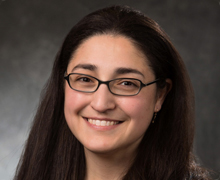Automated Insect Dissection for Laboratory and Field Research
Streamlining insect handling for faster workflow, higher throughput, and more uniform samples
Technology Overview
 Dr. Alexis KaushanskyMalaria kills more than 400,000 people a year. Children are especially vulnerable. No high-efficacy, long-lasting, effective vaccine is available for this complex disease. Researchers at Seattle Children’s Research Institute are studying ways to combat malaria, including developing vaccines against the Plasmodium falciparum and Plasmodium vivax parasites that cause it.
Dr. Alexis KaushanskyMalaria kills more than 400,000 people a year. Children are especially vulnerable. No high-efficacy, long-lasting, effective vaccine is available for this complex disease. Researchers at Seattle Children’s Research Institute are studying ways to combat malaria, including developing vaccines against the Plasmodium falciparum and Plasmodium vivax parasites that cause it.
Malaria is transmitted via mosquitoes. When a mosquito bites a human, the Plasmodium parasites enter the blood in mosquito saliva that contains them. Studying malaria and developing vaccines against it requires cultivating the mosquitoes that harbor Plasmodium and isolating the insect salivary glands that contain the highest number of the most infectious parasites.
Manually dissecting and processing mosquitoes to obtain salivary glands is tedious and time-consuming and produces inconsistent material. The parasites do not survive for long outside the insects so dissection must be fast. However, training to become a skilled dissector who can process hundreds of mosquitoes per hour takes months. To advance malaria research with faster, more reliable methods, Dr. Alexis Kaushansky and colleagues invented automated instruments for dissecting and grinding mosquito salivary glands to obtain live Plasmodium parasites.
The team developed an automated mosquito dissector with a robotic mechanical function that quickly separates the mosquito’s head and thorax from the abdomen, sorting the parts into detachable tubes for further processing. This invention significantly reduces dissection time. The team has data validating that parasites collected and processed using the automated instruments are comparable in number and quality to parasites obtained through manual processes. Many parts of the device can be 3D printed and adapted for multiple mosquito species for ecological, agricultural, and other applications.
Dr. Kaushansky’s group also invented an automated arthropod grinder. This device improves the efficiency, consistency, and productivity of grinding mosquito salivary glands and other insect-derived material before extracting infectious agents such as malaria parasites. This invention also has broad potential applicability, including for grinding ticks or beetles that carry pathogenic bacteria and viruses. This device can also be adapted for applications in plant and insect field research.
Dr. Kaushansky is interested in partnerships to develop the automated inventions for dissecting and processing mosquitoes and other insects.
Stage of Development
- Device development and validation
Partnering Opportunities
- Sponsored research agreement
- Device development
Publications
- Vijayan K, Cestari I, Mast FD, Glennon EKK...Kaushansky A., Plasmodium Secretion Induces Hepatocyte Lysosome Exocytosis and Promotes Parasite Entry. iScience. 2019 Nov 22;21:603-611. doi: 10.1016/j.isci.2019.10.054. Epub 2019 Oct 31.
- Tran TM, Guha R, Portugal S, Skinner J, Ongoiba A...Kaushansky A..., A Molecular Signature in Blood Reveals a Role for p53 in Regulating Malaria-Induced Inflammation. Immunity. 2019 Oct 15;51(4):750-765.e10. doi: 10.1016/vj.immuni.2019.08.009. Epub 2019 Sep 3.
- Kain HS, Glennon EKK, Vijayan K, Arang N, Douglass AN, Fortin CL...Kaushansky A., Liver stage malaria infection is controlled by host regulators of lipid peroxidation. Cell Death Differ. 2020 Jan;27(1):44-54. doi: 10.1038/s41418-019-0338-1. Epub 2019 May 7.
- Glennon EKK, Austin LS, Arang N, Kain HS, Mast FD, Vijayan K...Kaushansky A., Alterations in Phosphorylation of Hepatocyte Ribosomal Protein S6 Control Plasmodium Liver Stage Infection. Cell Rep. 2019 Mar 19;26(12):3391-3399.e4. doi: 10.1016/j.celrep.2019.02.085.
- Glennon EKK, Dankwa S, Smith JD, Kaushansky A. Opportunities for host-targeted therapies for malaria. Trends Parasit. 2018; 34:843-860.
- Arang N, Kain HS, Glennon EK, Bello T, Dudgeon DR, … Kaushansky A. Identifying host regulators and inhibitors of liver stage malaria infection using kinase activity profiles. Nature Communications. 2017: 1232.
- Douglass AN, Kain HS, Abdullahi M, Arang N, Austin LS, ... Kaushansky A. Host-based prophylaxis successfully targets liver stage malaria parasites. Mol Ther. 2015; 23: 857-865.
Learn More
To learn more about partnering with Seattle Children’s Research Institute on this or other projects, email the Office of Science-Industry Partnerships.
